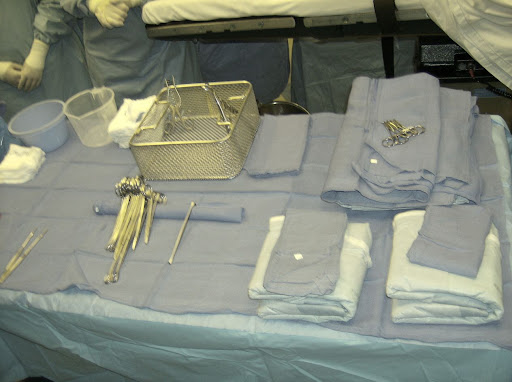
Now let’s go back to the operating room. Like I said before, when our instruments and supplies come to us they are sterile. It’s now our responsibility to make sure they stay that way.
A surgical tech is the person who sets up all the equipment so we have to learn how to do that and keep it sterile. It’s called sterile technique. And commonly we are the only person in the room when we set up. So if we accidentally touch the sterile field before we’ve scrubbed, gowned, and gloved no one knows it but us. It would be easy to contaminate the field and just act like it didn’t happen. But that exposes our patient to infection so we develop something called surgical conscience.
Surgical conscience is what tells us to break down that setup and start over rather than risk infecting our patient. Our motto is “When in doubt, throw it out”. We don’t play when it comes to sterility because that could cost someone their life. So if we suspect something has been contaminated, if someone else tells us there’s been a break in sterile technique, or if we just aren’t 100% sure we will consider it contaminated and we will get a new one or start all over.
Our sterile technique starts before we even go into the operating room. We put on clean scrubs when we get to the hospital, we cover our hair with scrub caps, and before we open the sterile equipment we put masks on.

The first thing we open is our back table pack (which includes the drapes we’ll use, gowns, towels, and other sterile equipment) touching only the outside of the package leaving everything on the inside sterile. We open all our instrument sets, other sterile supplies, and our own gown and gloves the same way.
Once everything is open, we scrub. One of the first skills we learn in school is how to scrub. Scrubbing renders our hand and arms (up to two inches above the elbow) surgically clean. Not sterile. that’s important because it’s impossible to kill and the microorganism on and in our skin. That’s why we have to wear a gown and gloves.
We use sterile scrub brushes that are impregnated with either Chlorahexidine or iodine and we methodically scrub our hands and arms for five minutes. We are very careful to keep our hands about our elbows so that the soapy lather and water runs off our elbows. This keeps our hands and the cleanest part. We make sure we don’t bump against anything which would contaminate us. We rinse and back into the O.R. make sure our arms remain above waist level.
Then it’s time to put on our gown. The gown is folded so that when we pick it up we only touch the inside of the gown. This keeps the outside of the gown sterile. Our hands remain inside the sleeves of the gown while we glove ourselves. And if it sounds difficult it’s because it kind of is. It’s gets much easier with practice though.
Once we have our gown and gloves on we are considered sterile from waist level to nipple line and from our fingers to two inches above our elbows. Only the front of our gown is considered sterile because we can’t properly monitor our backs so we consider them unsterile.
Now we can touch all that sterile stuff that we opened before we scrubbed. But we can only touch that sterile stuff. So then it would be time to organize our back table and put all our instruments out. We also will be gowning and gloving all the surgical team members who will be participating in the surgery.
From here it’s just all about monitoring the sterile field we just created. It’s my job to constantly be aware of how close nonsterile people and things come to my field. And any extra equipment I need also need to be sterile. And this keeps up until the surgery is over and the patient has been stitched up and has a dressing over the incision site. Every patient, every time.
We don’t do this because it’s fun. We do it to protect our patients. So before you starting reading this blog you may not have ever heard of a surgical tech. But if you’ve ever had surgery you can bet you had a surgical tech looking out for your health and well-being. My job is a lot of fun and I get to see some really cool things, but I also have a lot of responsibility














